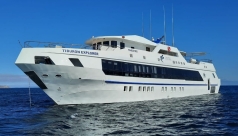In the history of human knowledge the Galapagos Islands play a starring role. It is here where Charles Darwin formulated much of his theory of evolution, a stunning breakthrough in unraveling the mysteries of life on planet Earth, the origins of living species, and natural selection. Now they are a protected national park of Ecuador, but are also an international treasure for scuba divers and lovers of nature throughout the world.
The
Galapagos National Park is the most popular tourist attraction in Ecuador. Santa Cruz's main town, Puerto Ayora, is the Galapagos' most developed and many tourists overnight here as it represents one of the only shopping opportunities in the islands. Santa Cruz is the most densely populated island and consists of a bay normally full of boats, tour desks, some shops, cafés and the national park headquarters.
A must-visit is
The Charles Darwin Research Station, some 10 minutes stroll from the town center. Here you can learn much of the details of Darwin's research and study. Established in 1959, the Darwin Station works closely with the national park, protecting the islands and marine reserve. It is a very interesting glance into the past and a tangible link to one of the most profound and elegant answers to some of the greatest mysteries of life.
Traveling to the
Highlands of Santa Cruz represents a great opportunity to experience the various 'life zones' of the Galapagos from the coast, through agricultural lands and up into misty forests. A great variety of birds can be found in the highlands. You will also
see many of the giant tortoises here in their natural habitat. In addition, there are fascinating volcanic elements to the landscape such as sink holes, lava tubes and craters.
2 of the best known craters are known as
Los Gemelos (The Twins) and they are an attraction in themselves with unique vegetation and a variety of bird life. A licensed guide will allow you to visit these areas and make the visit a special one full of interesting facts and sightings.
If you want the full land and sea experience of the Galapagos Islands, we recommend non-diving, wildlife liveaboard trips. Guests will get some experience of land creatures during their diving cruise, but the island chain has much more to offer than that brief exposure.












